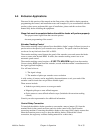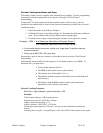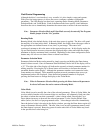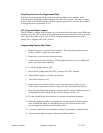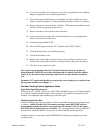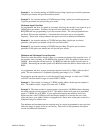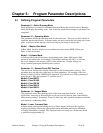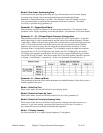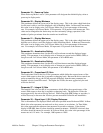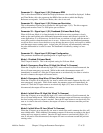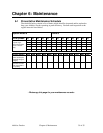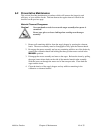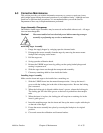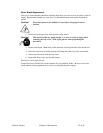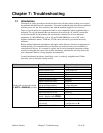Additive Feeders Chapter 5: Program Parameter Descriptions 36 of 55
Parameter 19 – Power-up Value
When Power-up Mode is set to 2, this parameter will designate the default display value at
power-up in display units.
Parameter 20 – Display Minimum
This parameter defines the lower end of the display range. This is the value which limits how
low the user is able to scroll the displayed value in Running Mode. In Rate and Time modes,
this value is set in display units. In Follower Mode, this is set in percentage of the master
rate. For example, in Follower Mode, 1250 represents 125.0 percent of the master rate. This
value can be changed but the feeder may not run consistently (choppy operation) if the
number of pulses per minute from the extruder are insufficient.
Parameter 21 – Display Maximum
This parameter defines the upper end of the display range. This is the value which limits how
high the user is able to scroll the displayed value in Running Mode. In Rate and Time modes,
this value is set in display units. In Follower Mode, this is set in percentage of the master
rate. For example, in Follower Mode, 150 represents 15.0 percent of the master rate.
Parameter 23 – Acceleration Setting
This parameter determines how fast the drive will accelerate toward the displayed target
setting. This parameter is set in display units of change per second such as RPM, GPM, or
feet per second. In Follower Mode, this parameter is set in RPM units.
Parameter 24 – Deceleration Setting
This parameter determines how fast the drive will decelerate toward the displayed target
setting. This parameter is set in display units of change per second such as RPM, GPM, or
feet per second. In Follower Mode, this parameter is set in RPM units.
Parameter 26 – Proportional (P) Gain
The Proportional Gain is the first of two parameters which define the responsiveness of the
control with respect to how fast it responds to changing loads. Because the drive controls are
pulse-accumulation drives, the P Gain responds differently than the same parameter in a
standard velocity-form PID control. The higher the P Gain, the more aggressively the unit
will drive the load.
Parameter 27 – Integral (I) Gain
The Integral Gain is the second of two parameters which define the responsiveness of the
control with respect to how fast it responds to changing loads. The higher the I Gain, the
more aggressively the unit will drive the load. When using high PPR pickups or encoders, it
will be necessary to decrease the I Gain to prevent unwanted oscillation and instabilities.
Parameter 30 – Signal Input 1 (S1) Display Reference
This is the number to be displayed when at the user-specified motor Reference RPM. In Rate
Mode, this value represents rate units such as feet, ounces, or revolutions. In Time Mode,
this value represents the reference time measured in seconds or minutes. If the desired
display is HH:MM, then all values should be entered in minutes. If MM:SS is desired, then
all values should be entered in seconds. In Follower Mode, this value is the percentage of the
master rate in 0.1% units. For example, 1000 equates to 100%.



